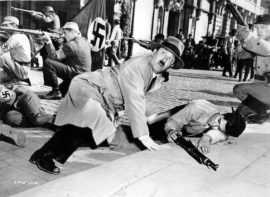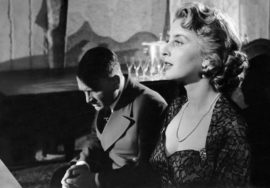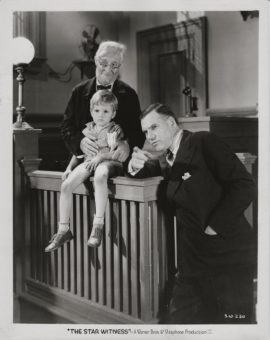
We’re back in Bologna, for the 28th edition of the wonderful Il Cinema Ritrovato, the film festival that gives film history the spotlight it rightly deserves. If some anti-cinema super-villain ever wanted to wipe out most of the world’s die-hard cinephiles, this would be the perfect place to start. As usual, we’ll be blogging regularly on the different programs the festival has on offer. We’ve already posted blogs on Alfred Machin and the William Wellman retrospective and there’s more coming up.

Halfway through the festival, it’s time to look back at what struck me most during those first four days. And speaking of super-villains, my festival started with John Farrow’s 1944 The Hitler Gang, something of an origin story, craftily executed but marked by a levity that – in light of the subject matter – might leave a bitter taste. The physical likeness of the protagonists to their real life counterparts is at times uncanny. ‚Fun’ fact: Martin Kosleck played Goebbels 5 times throughout his career, but came this close to being executed by a Gestapo death squad before fleeing Germany. He was also a Hollywood painter, responsible for some of the portraits that are so ubiquitous in 40s films. (More on that subject in Steven Jacobs’ and Lisa Colpaert’s excellent book, The Dark Galleries.) Ernest Lazlo’s noirish lighting is impeccable, as is Farrow’s direction, from the very start. The movie begins in a mental hospital with a scene that is almost played out in one take, including an expertly executed walk and talk. (The history of this storytelling device is outlined by David Bordwell on his blog.)
The second film I saw in the Il Cinema in guerra contra Hitler program, was one of the last films of Georg Wilhelm Pabst, the director that – according to Olaf Möller’s witty introduction – for many of his fans had died at the end of the silent period, while in fact he lived until 1967 and went on to make more than 20 ‚talkies’. This just to say that his non-silent work wasn’t very popular, at least until recently. Der Letzte Akt (1955) proved those nay-sayers wrong. It’s an inspired account of Hitler’s last days, strikingly similar in storyline to the recent Der Untergang (Oliver Hirschbiegel, 2004), but less sensationalist than the latter film. The thrilling apocalyptic ‚dance scene’ at the very end is one of the most terrifying and gratifying things I’ve seen so far. Pabst’s direction is excellent, and he knows how to get the right tone out of his actors, with Oskar Werner as the moral heart of the film. Albin Skoda (who according to IMDB only has 11 credits as an actor to his name) is perhaps less convincing, but just being spared Bruno Ganz’ hyperkinetic shaking hands makes me want to cut him some slack.

Now that we’re on the subject of hands, these extremities of our anatomy have been responsible for some of the more touching moments of my Ritrovato. A video on Bresson’s attention to hands has been doing the rounds on the internet recently, but he is of course far from the only director who enjoys playing with his actors hands. More specifically, two small moments in two completely unrelated films struck a chord with me.
In William Wellman’s early talkieThe Star Witness (1931), a young boy is kidnapped by a gang of hoodlums who are trying to keep the boy’s family from testifying against their boss. The whole ordeal is too much for the boy’s younger brother (child star Dickie Moore). When his mother carries him upstairs to put him to bed, Wellman shows us the scene from behind. We see the mother’s back as she carries her son in her arms, and just as they start climbing the stairs, his right hand falls down to the small of her back, where he almost unnoticeably gives her a little squeeze. A moment of extreme tenderness in a film which has the hardness of life seeping through every crack.

The second moment comes in Renoir’s Partie de campagne (1936), of which a gorgeous digital restoration was screened courtesy of the Cinémathèque française. Henri (Georges D’Arnoux) and Rodolphe (Jacques B. Brunius), two locals, have set their eyes on the women of a Parisian family visiting la campagne. Rodolphe decides for the both of them that he will take young Henriette (Sylvia Bataille) for a boat ride, while Henri will occupy himself with her mother, Madame Dufour. Henri seems to comply, but as soon as Rodolphe’s back is turned, he starts courting Henriette. The moment that struck me – although I had seen this film several times before – comes when Rodolphe catches Henri talking to Henriette for the first time. The latter two are holding hands, matter-of-factly, and Renoir doesn’t put any emphasis on this, framing the hands at the bottom of the screen and directing focus to the faces and the conversation. It’s only when Rodolphe comes up to the pair, interrupting the budding romance, and breaks apart the soon-to-be lovers, while talking Henriette’s hand in turn, that I really noticed how tenderly Henri and Henriette were holding hands.
It is one of the great joys of Il Cinema Ritrovato that I’ve been thinking about and looking at hands ever since.